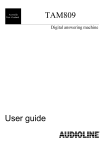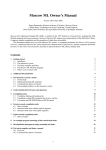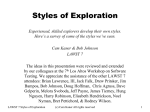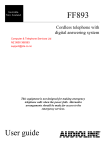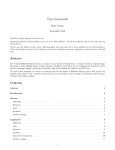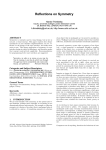Download Principled Dynamic Code Improvement
Transcript
Principled Dynamic Code Improvement
John Peterson
Paul Hudak
Gary Shu Ling
Yale University
Department of Computer Science
New Haven, CT 06520
{peterson-john,hudak,ling}@cs.yale.edu
Research Report YALEU/DCS/RR-1135
July 15, 1997
Abstract
A method for dynamically updating running code is described. The method is "principled" in that old functionality is not destroyed. Rather, new functionality is added which
can selectively and dynamically change the overall behavior of the system, yet all formal
properties of the original system are guaranteed to still hold. Higher-order functions are
the key to making this work, and an implementation in Hugs, a Haskell byte-code interpreter, is described.
0
1
Introduction
An increasingly common requirement of real-time software systems is the ability to update
code “on the fly;” that is, while the system is still running. For whatever reason, such systems
cannot afford to be shut down while the changes take place, and a redundant system design is
typically impractical. The need for such dynamic code improvements arises not only because
of conventional software bugs, but because of planned upgrades to the system for enhanced
or altered functionality that could not be predicted when the system was originally built.
Most programming languages and environments do not support dynamic code improvement. When viewed from the level of object code, an obvious requirement is a flexible linking
mechanism that allows modules to be swapped in dynamically. But additionally there needs
to be some kind of synchronization mechanism to allow switching from the old functionality
to the new, a mechanism to recover from linking errors, a means to reclaim unused code, and
possibly a persistent store.
Although the low-level details of linking and memory management are important, they are
for the most part straightforward, and several schemes have been successfully used. On the
other hand, solutions to the synchronization problem are less clear. Indeed, a problem with
existing mechanisms for dynamic code improvement is the lack of any principles by which
one can reason about the dynamics of change. What does it mean for a program to change its
behavior arbitrarily? What happens to formal properties that one might have proven about
a system in the presence of such potentially radical changes? How can new properties be
established, and how might they account for future changes?
In this paper we outline a simple strategy for principled dynamic code improvement that
solves most of these problems. Our strategy takes full advantage of the functionality of HOT
(“higher-order and typed”) programming languages, in that we rely critically on higher-order
functions to capture the dynamics of code improvement, and on types to capture conventional
compile-time safety. We have also implemented our ideas in the Hugs [6] implementation of
Haskell [5].
2
Principled Dynamic Code Improvement
Our basic idea is rather simple: instead of implicitly switching execution from one code block
to another, we will do so explicitly in the source language, using higher-order functions to
capture the components as “first-class citizens.” To make this work all we need is a way to
explicitly load and then invoke the new functionality. We will describe how this is done in our
Hugs implementation of Haskell,1 from which it should be clear how it might be done in some
other HOT language.
Haskell has a (rather conventional) module system which permits the usual control over
namespaces and facilitates separate compilation. Cross-module references need to be sorted
out at compile-time in the usual way: assuming that the module references form a DAG, the
1
Hugs development is being done in collaboration with the University of Nottingham.
1
modules may be loaded in any order that is a topological sort of the DAG. Hugs’ “import
chasing” feature in fact does this automatically for the user.
The thing to note is that, once a set of modules is loaded into a running system, the DAG
structure may be extended at the leaves without disturbing any of the previous references.
In other words, more modules could be loaded into the running system without the need for
re-directing any existing references. Indeed, Hugs permits this option manually for the user.
What is new is that we now make this option available to the programmer by adding to Haskell
the following monadic action:
loadAndGo
:: FName → IO ()
where FName is the filename being loaded (with the normal Hugs convention that filename
and module name match). Once loaded, the expression main is evaluated in the new module.
In essence, a call loadAndGo “M” transfers the execution context to main in the module M .
Since M is at the bottom of the module hierarchy, evaluation of main can reference any value
that has been imported from any pre-existing module. It can, in effect, transfer control again
to anywhere the programmer desires.
The only difficulty with this scheme is the absence of any kind of persistence. In particular,
there will likely be values that we would like to save and then restore during the transition
between old and new functionality. In a language with side effects, a global variable could be
used for this purpose. Although standard Haskell has no global variables, most implementations, including Hugs, support monadic references. Using these primitives we are able to
implement the following two functions:
saveState
:: SystemState → IO ()
restoreState :: IO SystemState
for any application-specific type SystemState.
2.1
A Simple Example
Suppose there is a module Top which implements a loop loop that depends on some state s
(an arbitrary value). Further suppose that somewhere in this loop the function f :: T 1 → T 2
is called whose functionality is intended to change dynamically when predicate p is true.
The loop, then, needs to be parameterized not just with s, but with f too. Suppose now
that somewhere in the loop the following monadic code is executed, shown here within the
structure of the module Top:
module Top (loop) where
loop
loop f s
:: (T 1 → T 2) → SystemState → IO ()
= ...
if p then do saveState (f , s )
loadAndGo “M”
else loop f s 2
where M is the name of the new module. If the predicate is false, the loop is executed normally
with some modified state s . But if it is true, f and s are saved, module M is loaded, and control
is passed to the evaluation of main.
Module M might look something like this:
module M where
import Top
newf
newf
:: T 1 → T 2
= ...
main
= do (oldf , olds) ← restoreState
loop newf olds
Note that the module Top is imported, thus allowing access to the function loop. Evaluation
of main results in restoration of the old state, after which loop is called with same old state
but with the newly loaded function newf . In general, the newly loaded module can import any
of the old ones (including ones loaded since compile-time), do a restoreState, and then call a
re-entry point with arbitrary functionality.
Clearly in order to use our technique one must be able to anticipate in advance exactly which
pieces of code might be updated. In fact, this is true of all existing methods that we know of,
which is not surprising given the synchronization problem: the extent of the dynamics needs
to be delimited somewhere. In the worst case, there might be a single function delimiting the
functionality of the entire program, thus allowing a complete change in functionality.
2.2
Errors
It is important to realize that loadAndGo cannot redefine any existing functions. If this were
attempted, the result would be the same as if the module were loaded at compile time: a
name-clash error would occur. The only difference is that now the error happens at run-time.
Because of this possiblilty of run-time error, of course, care must be taken to provide a
means to recover from it. This is easily done in Haskell using its monadic catch operator. As
an example, here is a rewrite of the conditional in the loop given earlier, that restores the old
functionality if a loading error occurs:
if p then do saveState (f , s )
catch (loadAndGo “M”) (\e → loop f s )
else loop f s This version ignores the specifics of the error e and simply loops with the old functionality,
but it is also possible to inspect e and react differently depending on the type of error that
has occurred (the important cases being “file not found” and “compilation error”).
3
2.3
Reasoning About Change
Since the new module cannot redefine any existing bindings, any formal properties of the
original system must still hold in the new. For instance, in the example above, any properties
involving f , loop, etc. must still hold. Indeed, it may be that the old functionality (for example,
the function f ) is still used in some other parts of the system, and we certainly don’t want
those parts to become suddenly inoperative (an example of this arises later when we consider
concurrency).
On the other hand, if the operative aspect of the system is the combination of loop and
its parameterized function f , then presumably there are properties about the combination of
loop and f that must be reestablished for loop and newf . Nevertheless, this kind of reasoning
is perfectly sound, and one can hardly expect to do less work than this.
To facilitate equational reasoning, the following program is equivalent to the one given
earlier, assuming that a run-time error did not occur as a consequence of loading the new
module:
module Top (loop) where
import qualified M (main)
loop
loop f s
:: (T 1 → T 2) → SystemState → IO ()
= ...
if p then do saveState (f , s )
M .main
else loop f s In other words, the new system is equivalent to the system that would have resulted from
loading the new module at the very beginning. Note how main from module M is explicitly
imported and evaluated in the appropriate context.
This program equivalance permits us to use conventional equational reasoning when proving properties about the new system. For example, no dynamic lookup of names in a symbol
table is required. We should also point out that Haskell’s type system ensures that the additional functionality is type-safe: that is, type errors cannot occur at run-time. This is an
important property when dealing with dynamic change, and is notably better than, for example, the type casting that results when using dynamic types in a language such as Java.
2.4
Concurrency
Sometimes it is desirable to swap in new functionality gradually instead of all at once as we
have described above. For example, a server in a client-server architecture might communicate with multiple clients whose requests overlap in time. When the server functionality is
upgraded, it may be desirable for the old server to finish any requests it is currently processing, while at the same time the new server picks up any new requests.
4
Our approach to dynamic code improvement deals nicely with this situation. Since the new
functionality does not destroy any of the old, both can exist simultaneously; all that is needed
is some form of concurrency. Concurrent Haskell (supported by Hugs), for example, allows
one to fork off concurrent threads of computation, each independently performing IO actions:
do fork p1
p2
Here p1 is forked while the current thread continues with p2. Communication between process
is accomplished in one of a number of ways, including CSP-like channels.
To solve the server-client scenario, the scheduler for the server might fork off an instance
of a “server function” for each request that arrived. Each of these instances would run in
parallel until it completes its task (which might take seconds, hours, or weeks). Initially the
scheduler would use whatever server function was originally installed, but if a new server
function were dynamically loaded, it would start using that one, and so forth. So at any one
time, there may be instances of many different server functions running. But, as the olds ones
die off, they will be automatically purged from the system by the garbage collector.
2.5
Code Reclamation
As implied above, data structures and function closures created from the old functionality—
say a closure for the function f in the earlier example—would naturally be reclaimed by the
garbage collector soon after they are not needed any more. However, as new functionality
is added to the system, the amount of static code also increases, possibly eventually causing
memory space problems. The solution to this is to extend the garbage collection mechanism
to include the reclamation of unused code. Hugs does not currently do this, but there are no
technical problems preventing it.
2.6
Capitalizing on Type Classes
Another common approach to dynamic code improvement is based on object oriented programming. In this style, new objects, derived from pre-defined classes, are dynamicly added
to a running system. The pre-defined classes serve as an interface by which dynamicly loaded
objects interact with existing code.
The Haskell type class system, together with the ideas introduced earlier, can be used to
achieve the same effect. Consider a program similar to the previous example in which a loop
is defined in terms of a value which is a member of a particular class, instead of having a fixed
type:
loop
loop obj s
:: C a ⇒ a → SystemState → IO ()
= ...
The code in ... uses methods in the class C to interact with the value obj. Now a dynamicly
loaded file can define a new data type as an instance of the class C and pass new values of this
5
type into the loop, thus allowing the set of methods associated with the class to be redefined
by the new object. For example:
module M where
data NewType = ...
instance C NewType where
method1 = ...
method2 = ...
v
v
:: NewType
= ...
main
= do olds = restoreState
loop v olds
This, in effect, packages up a group of related functions into a single object which is much
easier to pass through the program. In fact, the methods associated with Haskell classes
are passed implicitly rather than explicitly, making the use of dynamicly loaded class instances less intrusive on the program than passing changable functions explicitly through
the program.2
2.7
Doing Without Persistence
It is possible to do away with the need for persistence by calling main directly with the desired
state. Although we have not implemented this idea, it presents only a modest increase in
implementation complexity, and is an arguably cleaner design.
Recall that the type of loadAndGo is FName → IO (), and main in the newly added module
must have type IO (). Instead, we could use the following type for loadAndGo:
loadAndGo
:: FName → a → IO ()
The idea is that, instead of saving and restoring the state explicitly, we can design loadAndGo
such that it passes its second argument to main directly. If the type of that argument is T ,
then main would be expected to have type T → IO (). The previous example could then be
rewritten as:
module Top (loop) where
loop
loop f s
:: (T 1 → T 2) → SystemState → IO ()
= ...
if p then loadAndGo “M” (f , s )
else loop f s 2
In reality, this method for dynamic code improvement requires existential types to implement properly, which
does not exist in standard Haskell but is supported by several Haskell implementations.
6
module M where
import Top
newf
newf
:: T 1 → T 2
= ...
main
:: (T 1 → T 2, SystemState) → IO ()
main (oldf , olds) = loop newf olds
Note the type of main: it takes as argument the state that was previously being saved and
restored.
To implement this idea simply requires that Hugs be informed of the instantiated type of
the second argument to loadAndGo at run-time, so that it can perform the proper type-check
on main.
3
Related Work
One of the most widely-cited examples of dynamic code improvement is that done for telephone switching systems, where clearly any interruption of service cannot be tolerated. Unfortunately, most of this work has been done in commercial environments, and we do not have
any documentation describing it.
There is one notable exception to this, however, based on the functional language Erlang
[2, 7] developed and used extensively by Ericsson in its telephone switching systems. That
Erlang is a functional language is notable in its own right, but its support for dynamic code
improvement is less principled than ours: existing modules can actually be edited and recompiled while the system is running. Although obviously flexible, such an approach presents
dangerous opportunities for error, and makes the task of program verification extremely difficult. The approach also seems to rely inherently on the tail-recursive nature of top-level
code.
Of course, Lisp systems have supported a form of dynamic code improvement for many
years: new files may be dynmically loaded under programmer control at any time. Unfortunately, the method is highly unprincipled. Not only can any function be arbitrarily redefined,
for example, but not every implementation supports this in the same way, some behave differently when compiled vs. interpreted, and the Scheme standard [3] is silent on the issue.
Problems arise especially when mutually recursive functions are redefined. In general this “imperative” style of reloading code, shared by many other systems such as the ones discussed
below, results in an unprincipled solution to dynamic code improvement.
Appel [1] discusses support for dynamic code improvement in SML of New Jersey [4], citing
many of the issues that we have reported here. SML/NJ allows any module in an acyclic module
system to be replaced, and uses indirection to avoid costly relinking (much like a conventional
Lisp system). It also performs garbage collection of unused code.
7
One might also consider OLE, COM, Corba, and other approaches to component-based
interoperability as viable mechanisms for implementing dynamic code improvement. Again,
however, the result is far from disciplined. One does not generally even know if the same object
will be invoked every time that it is called. The fact is, these component-based technologies
are really solving a different problem, and are thus not the ideal solution for dynamic code
improvement.
4
Acknowledgement
Thanks to Alastair Reid for help in implementing these ideas in Hugs. We also wish to thank
our sponsors, Darpa and NSF, who have supported this research through Rome Labs contract
number F30602-96-2-0232 and NSF grant number CCR-9633390, respectively.
References
[1] Andrew W. Appel. Hot sliding in standard ml, December 1994. unpublished manuscript.
[2] J.L Armstrong and S.R. Virding. Erlang – an experimental telephony programming language,
June 1990.
[3] Clinger, W. et al. The revised revised report on scheme, or an uncommon lisp. AI Memo
848, Massachusetts Institute of Technology, August 1985.
[4] Robert Harper, Robin Milner, and Mads Tofte. The definition of standard ml version 2.
Technical Report ECS-LFCS-88-62, Laboratory for Foundations of Computer Science, Department of Computer Science - University of Edinburgh, August 1988.
[5] P. Hudak, S. Peyton Jones, and P. Wadler (editors). Report on the Programming Language
Haskell, A Non-strict Purely Functional Language (Version 1.2). ACM SIGPLAN Notices,
27(5), May 1992.
[6] Mark P. Jones and John C. Peterson.
Hugs 1.4 User Manual.
Research Report
YALEU/DCS/RR-1123, Yale University, Department of Computer Science, 1997.
[7] M. Persson, K. Odling, and D. Eriksson. A switching software architecture prototype using
real time declarative language, 1993.
8














